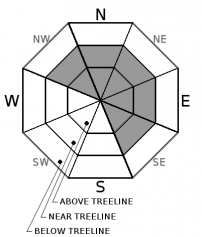| Tuesday | Tuesday Night | Wednesday | |
|---|---|---|---|
| Weather: | Mostly cloudy with scattered showers that are a mix of rain and snow throughout the day. Snow level 7500 ft. | Mostly cloudy | Mostly cloudy |
| Temperatures: | 40 to 45 deg. F. | 30 to 35 deg. F. | 46 to 51 deg. F. |
| Mid Slope Winds: | Southwest | Southwest | Southwest |
| Wind Speed: | 10 to 15 mph with gusts to 45 mph decreasing to 30 mph in the afternoon | Light increasing to 10 to 15 mph with gusts to 30 mph after midnight | 10 to 15 mph with gusts to 30 mph |
| Expected snowfall: | Rain: up to .1 in. | Snow up to 2 | 0 | 0 |
| Tuesday | Tuesday Night | Wednesday | |
|---|---|---|---|
| Weather: | Mostly cloudy with scattered snow showers throughout the day. Snow level 7500 ft. | Mostly cloudy | Mostly cloudy |
| Temperatures: | 37 to 43 deg. F. | 29 to 34 deg. F. | 43 to 48 deg. F. |
| Ridge Top Winds: | Southwest | Southwest | Southwest |
| Wind Speed: | 20 to 35 mph with gusts to 70 mph decreasing to 50 mph in the afternoon | 15 to 25 mph with gusts to 35 mph increasing to 50 mph after midnight | 15 to 25 mph with gusts to 45 mph |
| Expected snowfall: | up to 2 | 0 | 0 |


























